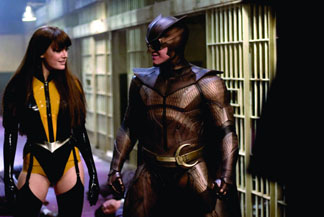|
|
Book vs. MovieWatchmenBy Russ BickerstaffMarch 9, 2009
Watchmen Having received acclaim in both mainstream and comic book circles, Alan Moore and Dave Gibbons' graphic novel Watchmen is probably the single most respected super hero story in the history of the genre. The mid to late 1980s deconstruction of the superhero genre was written in a way that was originally intended to show those qualities unique to the comic book medium. In spite of this, there have been numerous attempts to adapt the story to film dating back to 1986, when the series hadn't even been completed yet. Over the course of the past two decades, many names have been attached to the film adaptation, including Joel Silver, Sam Hamm, Terry Gilliam, David Hayter, Darren Aronofsky, Daniel Craig, Jude Law and Sigourney Weaver. Finally, in 2006 it was announced that 300 director Zack Snyder would be directing the project. Snyder has endeavored to be very true to the comic book his move is based on, but can even the most faithful film adaptation hope to capture the essence of a story that was meant for another medium? The Book In 1982, British publisher Eagle Comics acquired the rights to Marvelman — a grandiose Superman-like hero from the golden age of British comic books. Soon-to-be-acclaimed British author Alan Moore was given the opportunity to work with the character and promptly went about updating him for a much darker, contemporary world. Remaining true to the stories that had made the character so popular, Moore explained away the grandiose ‘50s adventures of the hero as a sinister pseudo-virtual reality experiment that didn't actually happen in the real world...creepy, but kind of a cop-out. When US comic book publisher DC Comics acquired the rights to a line of golden age super-heroes from the now defunct Charlton Comics, Moore approached them with the idea of showing what happened between the panels of all those larger-than-life, black and white ,good vs. evil superhero stories of the 1950s. DC liked the idea, but didn't relish the idea of giving Moore the Charlton characters to work with, presumably since they had paid good money for them. Moore was allowed to re-work his dark super hero story with all-new characters based off of the ones he'd intended on using from DC's Charlton comics acquisition. The resulting story ended up spanning much of the 20th century and featured heroes drawn from just about every major type of hero seen in mainstream comic books. It explored the nature of heroism from the era of the masked crime fighters of the pulp era to the costumed heroes of World War II and the golden age of comics, following through to the dark times of the silver age in a post Watergate, post-Vietnam, post-nuclear era. The series was completed as the ‘80s heat-up of the cold war was about to end it.
[ View other columns by Russ Bickerstaff ]
[ View other Book vs. Movie columns ]
[ Email this column ]
|

|
|
|

|
Friday, November 1, 2024
© 2024 Box Office Prophets, a division of One Of Us, Inc.


